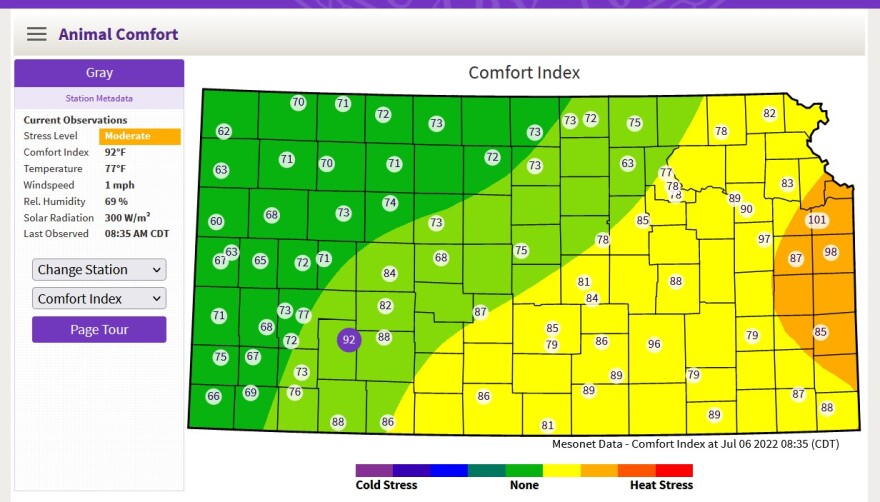HAYS, Kansas — Rancher Scott Whiting heard stories about all kinds of extreme weather growing up in western Kansas.
Blizzards, dry spells and heat waves commonly peppered the tales his parents and grandparents told about the land the family has lived on in Lane County for nearly 150 years.
So he knew that trying to shield cattle from the elements came with the job.
“It’s just a brutal area,” Whiting said. “It’s a land of extremes.”
But the combination of dangerous weather conditions that struck the region last month — killing thousands of cattle — took those extremes to another level.

- Here's how this year's drought has battered the Midwest — and what it might mean for next year
- The heat killed so many Kansas cattle in June that the only place to take carcasses was a landfill
- This city in Kansas really conserves its water, but that still might not be enough to survive
- One year after wildfires, Kansas ranchers vow to ‘get by ... somehow’
- Here are 7 ways this dry, hot year stacks up against the worst droughts in Kansas history
- Western Kansas wheat crops are failing just when the world needs them most
- How the drought killing Kansas corn crops could make you pay more for gas and beef
- Up to 1 million birds count on Kansas wetlands during migration. Drought has left them high and dry
- How Kansas could lose billions in land values as its underground water runs dry
- As fertilizer pollutes tap water in small towns, rural Kansans pay the price
- Kansas wildfire responders brace as a dangerously dry, windy season drags on
- How an increasingly brutal Kansas climate threatens cattle’s health and ranchers' livelihoods
- A hotter, drier climate and dwindling water has more Kansas farmers taking a chance on cotton
Daytime high temperatures jumped from the mid-60s to well over 100 degrees in a matter of days, accompanied by unusually high humidity and calm winds. The seasons changed from cool spring to hot summer so quickly that a lot of Whiting’s cattle didn’t even have a chance to shed their long, thick winter coats.
He watched as some of them climbed into their drinking water tanks — something he’d never seen them do before — as they desperately tried to cool off.
“It’s one of those deals where you hope for the best,” Whiting said. “There’s not a whole lot you can do. … It was just a worst-case scenario.”
Forecast data from USDA: https://t.co/hYctPBJ7vU
— Kansas Mesonet (@ksmesonet) June 16, 2022
As forecasts point to a warmer-than-average summer and climate change turns up nighttime temperatures, heat stress among the state’s millions of cattle continues to be a growing concern.
Ranching makes up the largest share of the state’s agriculture industry — generating nearly $9 billion per year, compared to just over $5 billion from Kansas grain farming. So finding ways to keep cattle cool in a warming climate is also critical to the state’s economy.

No relief
It’s not just heat that makes a given day’s weather dangerous for cattle.
Chip Redmond, a meteorologist with the statewide climate monitoring systemKansas Mesonet, said humidity, wind speed and sun exposure can all be just as vital in determining how potentially deadly conditions may be.
That’s why the Mesonet puts out an animal comfort index — similar to a heat index for humans. It takes all of those factors into account and tells livestock owners when and where the conditions are most dangerous.
“Anything over 105 (on the comfort index),” Redmond said, “you could expect potentially up to 5% losses of outdoor livestock, if they’re not taken care of.”
Extremely high cattle stress this weekend in southwest Kansas.
— Kansas Mesonet (@ksmesonet) June 13, 2022
Historical/real-time data here: https://t.co/hOrMOzBTN4#kswx pic.twitter.com/OQZOh9PX4n
Timing matters. That’s a big part of what made the heat wave that killed thousands of Kansas cattle last month so extraordinary.
After enjoying a few weeks of cool weather in late May and early June, temperatures shot up rapidly. That meant two things.
First, the cattle didn’t have time to acclimate to those warmer temperatures.
Secondly, the moist air that accompanied the cool spring weather didn’t have time to clear out before the heat quickly moved in.
So almost overnight, cattle went from mild weather to a Great Plains steam bath.
“You had that overlap of about 24, 36, even 48 hours where you had that humidity still present with the high temperatures,” Redmond said. “That’s got the potential to be more dangerous.”
So contrary to conspiracy theories peddled on social media that the cattle were purposefully killed by Bill Gates or government chemtrails, it was simply the wrong weather at the wrong time. Redmond’s team is now researching past weather events that caused mass cattle die-offs in Kansas to see if they can find common threads between those disasters and the one that happened last month.
And while the extraordinary combination of factors that created that event are unlikely to repeat this summer, Redmond sees another trend that could still put Kansas cattle at risk: rising nighttime temperatures driven by climate change.

Dodge City experienced its warmest overnight minimum temperature ever last month. The low of 83 degrees on June 13th was the city’s highest in recorded history dating back nearly 150 years.
Research shows that average overnight lows in Wichita steadily rose by 2.7 degrees from 1970 to 2020
When it doesn’t cool off overnight, Redmond said, that robs cattle of their only chance to recover from the heat of the day. And that could make heat stress an even bigger problem in the coming years.
“Those warmer overnight temperatures will be your biggest factor,” Redmond said. “When we keep warmer temperatures at night, that usually infers more humidity, and additional humidity with warmer temperatures usually leads to increased stress.”

‘Nature can be pretty cruel’
Heat stress fueled by climate change already costs the American cattle industry up to $370 million each year. A recent Cornell University study found that if global temperatures continue rising, heat stress could cost the world’s cattle producers $40 billion a year by the end of this century.
And even if heat-stressed cattle avoid death, they could still experience other lingering effects such as low weight gain, poor milk production or fertility problems. That could further endanger fragile global food systems that are already being strained by a changing climate.
Dr. Erika Nagorske, a livestock veterinarian who partners with the national agriculture group Farmers Business Network, said heat stress is one of the top concerns among the producers she deals with in southwest Minnesota.
“It’s definitely always on our mind in the agriculture industry,” Nagorske said, “especially this time of year.”
While cattle are adaptable creatures, she said, rising nighttime temperatures pose a particularly grave threat.
“We’ve raised cattle in this part of the world and in Kansas for a very long time,” Nagorske said. “But where it becomes problematic is when it doesn’t cool off at night, when there’s just never a break.”
Warmer-than-normal temperatures, especially at night, can cause heat stress to develop rapidly in #livestock. The @ksmesonet has an Animal Comfort tool that helps track heat stress values at each location throughout the state. Check it out here: https://t.co/nOhCKanO0z pic.twitter.com/sX25hgs4Me
— K-State Agronomy (@KStateAgron) June 20, 2022
There’s not much ranchers can do to cool the night air, but Nagorske said there are several practical steps they could take to limit the risk to their herd.
- A cattle’s stomach generates a lot of internal heat, so feeding them during cooler nighttime hours can allow them to digest without overheating. There is also a variety of electrolyte products that can be added to feed — basically Gatorade for cattle — to help prevent dehydration.
- Giving cattle access to mounds or hills — elevated spots where the breeze is likely to be a few miles per hour stronger — offers them opportunities to regulate their temperature.
- Controlling flies lets cattle feel comfortable to spread out, which cools them down more than bunching up.
- In a region that doesn’t have many trees, cattle crowding close together under bits of scarce shade can block the breeze and raise their body temperatures. So Nagorske said installing a shade shelter might help.
But the most critical thing cattle producers can do is provide plenty of water.
The amount of water cattle drink doubles from winter to summer. On a hot day, Nagorske said, a 1,500-pound steer could drink up to 30 gallons — roughly enough to fill a bathtub.

At his ranch in Lane County, Whiting said his cattle made it through the extreme June weather, shed their winter hair and have now adjusted to the recent 100-degree temperatures.
“Events like that have happened before. They're gonna happen again,” Whiting said. “You just gotta keep on ranching.”
But he is already taking steps to prepare for future western Kansas heat.
He tries to have a few days worth of water on hand at all times, just in case one of his well pumps breaks down. Sometimes, he sets up sprinklers that run droplets of water over the cattle.
He’s also begun transitioning his herd from Black Angus cattle to other breeds that have lighter coloring. Research has shown that cattle with black hair are especially vulnerable to the effects of heat stress from sun radiation, just like a person who wears a black shirt on a hot day.
Whiting's main concern going forward is how the ongoing drought in western Kansas has stunted and shriveled the grass on his pasture. If the animals don’t get enough nutrition to stay strong, that could make them more vulnerable to the next heat wave.
And if the wrong weather conditions combine again like they did last month, he knows that protecting them from it might be out of his control.
“You go to every extreme you can think of,” Whiting said, “but sometimes nature can be pretty cruel.”
David Condos covers western Kansas for High Plains Public Radio and the Kansas News Service. You can follow him on Twitter @davidcondos.
The Kansas News Service is a collaboration of High Plains Public Radio, Kansas Public Radio, KCUR and KMUW focused on health, the social determinants of health and their connection to public policy.
Kansas News Service stories and photos may be republished by news media at no cost with proper attribution and a link to ksnewsservice.org.








